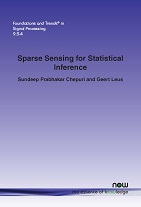Sparse Sensing for Statistical Inference
By Sundeep Prabhakar Chepuri, Delft University of Technology, The Netherlands, s.p.chepuri@tudelft.nl | Geert Leus, Delft University of Technology, The Netherlands, g.j.t.leus@tudelft.nl
Abstract
In today’s society, we are flooded with massive volumes of data in the order of a billion gigabytes on a daily basis from pervasive sensors. It is becoming increasingly challenging to sense, store, transport, or process (i.e., for inference) the acquired data. To alleviate these problems, it is evident that there is an urgent need to significantly reduce the sensing cost (i.e., the number of expensive sensors) as well as the related memory and bandwidth requirements by developing unconventional sensing mechanisms to extract as much information as possible yet collecting fewer data.
The aim of this monograph is therefore to develop theory and algorithms for smart data reduction. We develop a data reduction tool called sparse sensing, which consists of a deterministic and structured sensing function (guided by a sparse vector) that is optimally designed to achieve a desired inference performance with the reduced number of data samples. We develop sparse sensing mechanisms, convex programs, and greedy algorithms to efficiently design sparse sensing functions, where we assume that the data is not yet available and the model information is perfectly known.
Sparse sensing offers a number of advantages over compressed sensing (a state-of-the-art data reduction method for sparse signal recovery). One of the major differences is that in sparse sensing the underlying signals need not be sparse. This allows for general signal processing tasks (not just sparse signal recovery) under the proposed sparse sensing framework. Specifically, we focus on fundamental statistical inference tasks, like estimation, filtering, and detection. In essence, we present topics that transform classical (e.g., random or uniform) sensing methods to low-cost data acquisition mechanisms tailored for specific inference tasks. The developed framework can be applied to sensor selection, sensor placement, or sensor scheduling, for example.
A Signal Processing Perspective of Financial Engineering
Sensors are becoming increasingly omnipresent throughout society. These sensors generate a billion gigabytes of data every day. With the availability of immense computing power at central locations, the local storage and transmission of the data to a central location becomes the bottleneck in the real-time processing of the mass of data. Recently compressed sensing has emerged as a technique to alleviate these problems, but much of the data is blindly discarded without being examined to achieve acceptable throughput rates.
Sparse Sensing for Statistical Inference introduces and reviews a new technique called Sparse Sensing that reduces the amount of data that must be collected to start with, proving an efficient and cost-effective method for data collection. This monograph provides the reader with a comprehensive overview of this technique and a framework that can be used by researchers and engineers in implementing the technique in practical sensing systems.
